
A dictionary is a listing of lexemes from the lexicon of one or more specific languages, often arranged alphabetically, which may include information on definitions, usage, etymologies, pronunciations, translation, etc. It is a lexicographical reference that shows inter-relationships among the data.
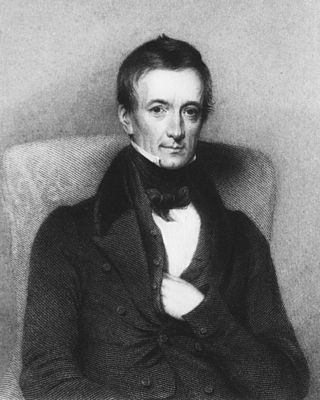
Peter Mark Roget was a British physician, natural theologian, lexicographer and founding secretary of The Portico Library. He is best known for publishing, in 1852, the Thesaurus of English Words and Phrases, a classified collection of related words. He also read a paper to the Royal Society about a peculiar optical illusion in 1824, which is often regarded as the origin of the persistence of vision theory that was later commonly used to explain apparent motion in film and animation.
Roget's Thesaurus is a widely used English-language thesaurus, created in 1805 by Peter Mark Roget (1779–1869), British physician, natural theologian and lexicographer.
A thesaurus or synonym dictionary is a reference work for finding synonyms and sometimes antonyms of words. They are often used by writers to help find the best word to express an idea:
...to find the word, or words, by which [an] idea may be most fitly and aptly expressed
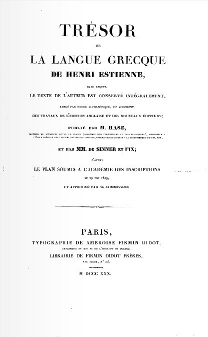
Henri Estienne, also known as Henricus Stephanus, was a French printer and classical scholar. He was the eldest son of Robert Estienne. He was instructed in Latin, Greek, and Hebrew by his father and would eventually take over the Estienne printing firm which his father owned in 1559 when his father died. His most well-known work was the Thesaurus graecae linguae, which was printed in five volumes. The basis of Greek lexicology, no thesaurus would rival that of Estienne's for three hundred years.

Random House Webster's Unabridged Dictionary is a large American dictionary, first published in 1966 as The Random House Dictionary of the English Language: The Unabridged Edition. Edited by Editor-in-chief Jess Stein, it contained 315,000 entries in 2256 pages, as well as 2400 illustrations. The CD-ROM version in 1994 also included 120,000 spoken pronunciations.
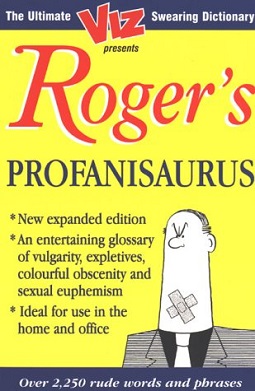
Roger's Profanisaurus is a humorous book published in the United Kingdom by Dennis Publishing which is written in the style of a lexicon of profane words and expressions. The book is marketed as "the foulest-mouthed book ever to stalk the face of the earth".
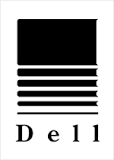
Dell Publishing Company, Inc. is an American publisher of books, magazines and comic books, that was founded in 1921 by George T. Delacorte Jr. with $10,000, two employees and one magazine title, I Confess, and soon began turning out dozens of pulp magazines, which included penny-a-word detective stories, articles about films, and romance books.
Beryl T. "Sue" Atkins was a British lexicographer, specialising in computational lexicography, who pioneered the creation of bilingual dictionaries from corpus data.

14,000 Things to Be Happy About is a book by Barbara Ann Kipfer. Illustrated by Pierre Le-Tan. It was published in 1990 by Workman Publishing. The book is a list of about 14,000 random and sometimes abstract items, apparently compiled by the author over the course of 20 years. More than one million copies have been sold. It was ranked 11th on the 1990 paperback bestseller list. The 25th anniversary edition was published in 2014.
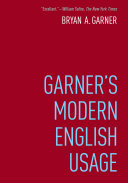
Garner's Modern English Usage (GMEU), written by Bryan A. Garner and published by Oxford University Press, is a usage dictionary and style guide for contemporary Modern English. It was first published in 1998 as A Dictionary of Modern American Usage, with a focus on American English, which it retained for the next two editions as Garner's Modern American Usage (GMAU). It was expanded to cover English more broadly in the 2016 fourth edition, under the present title. The work covers issues of usage, pronunciation, and style, from distinctions among commonly confused words and phrases to notes on how to prevent verbosity and obscurity. In addition, it contains essays about the English language. An abridged version of the first edition was also published as The Oxford Dictionary of American Usage and Style in 2000.
Robert Lundquist Chapman was an American professor of English literature who edited several dictionaries and thesauri.
Jonathon Green is an English lexicographer of slang and writer on the history of alternative cultures. Jonathon Green is often referred to as the English-speaking world's leading lexicographer of slang, and has even been described as "the most acclaimed British lexicographer since Johnson".
Reinhard Rudolf Karl Hartmann is an Austrian and English lexicographer and applied linguist. Until the 1970s, lexicographers worked in relative isolation, and Hartmann is credited with making a major contribution to lexicography and fostering interdisciplinary consultation between reference specialists.
The New World of English Words, or, a General Dictionary is a dictionary compiled by Edward Phillips and first published in London in 1658. It was the first folio English dictionary.
Francis Gouldman was a Church of England clergyman and lexicographer whose Latin-English dictionary (1664) went through several editions. Gouldman was also one of the directors who oversaw the publication of the monumental Critici sacri, a major collection of Biblical criticism.
Norman Lewis was an author, grammarian, lexicographer, and etymologist. Lewis was a leading authority on English-language skills, whose best-selling 30 Days to a More Powerful Vocabulary published by Pocket Books in 1971 promised to teach readers "how to make words your slaves" in fifteen minutes a day.
This page is a glossary of archaeology, the study of the human past from material remains.
The Dictionary of American Slang was edited by Stuart Flexner and Harold Wentworth and first published in 1960 by Thomas Crowell Company. The first three editions were edited by Flexner and Wentworth, while the fourth (1995) and fifth editions (2010) were largely reworked and edited by Barbara Ann Kipfer and Robert L. Chapman

Arvind Kumar was an Indian journalist, art-drama-film critic, short story writer, translator, and lexicographer.








